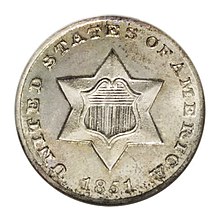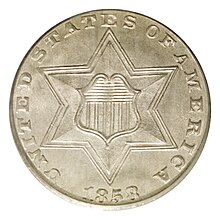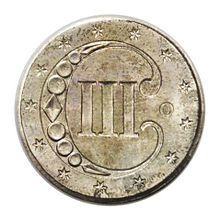
Back Tri-cenda arĝentaĵo (Usona monero) Esperanto Moeda de prata de 3 centavos de dólar estadounidense Galician Три цента США (серебряная монета) Russian 3美分银币 Chinese
United States | |
| Value | 3 cents (0.03 US dollars) |
|---|---|
| Mass | 1851–1853, .80 g. Later pieces, .75 g |
| Diameter | 14 mm |
| Edge | plain |
| Composition | 1851–1853, .750 silver, .250 copper. Later pieces, .900 silver, .100 copper |
| Silver | 1851–1853, .0193 troy oz. Later issues, .0217 troy oz |
| Years of minting | 1851–1873 |
| Mint marks | O (1851 only). To the right of the Roman numeral on the reverse. Philadelphia Mint specimens struck without mint mark. |
| Obverse | |
 | |
| Design | Type 1 |
| Designer | James B. Longacre |
| Design date | 1851 |
| Design discontinued | 1853 |
 | |
| Design | Type 2 |
| Designer | James B. Longacre |
| Design date | 1854 |
| Design discontinued | 1858 |
| Design | Type 3 |
| Designer | James B. Longacre |
| Design date | 1859 |
| Design discontinued | 1873 |
| Reverse | |
 | |
| Design | Type 1 |
| Designer | James B. Longacre |
| Design date | 1851 |
| Design discontinued | 1853 |
| Design | Types 2 and 3 |
| Designer | James B. Longacre |
| Design date | 1854 |
| Design discontinued | 1873 |
The three-cent silver, also known as the three-cent piece in silver or trime, was struck by the Mint of the United States for circulation from 1851 to 1872, and as a proof coin in 1873. Designed by the Mint's chief engraver, James B. Longacre, it circulated well while other silver coinage was being hoarded and melted, but once that problem was addressed, became less used. It was abolished by Congress with the Coinage Act of 1873.
After a massive importation of gold bullion during the California Gold Rush, silver could be traded for increasing amounts of gold, so U.S. silver coins were exported and melted for their metal. This, and the reduction of postage rates to three cents, prompted Congress in 1851 to authorize a coin of that denomination made of .750 fine silver, rather than the conventional .900. The three-cent silver was the first American coin to contain metal valued significantly less than its face value, and the first silver coin not to be legal tender for an unlimited amount. The coin saw heavy use until Congress acted again in 1853, making other silver coins lighter, which kept them in circulation. Congress also lightened the three-cent silver, and increased its fineness to 900 silver.
With the return of other denominations to circulation, the three-cent silver saw less use, and its place in commerce was lost with the economic chaos of the American Civil War, which led to hoarding of all gold and silver coins. A three-cent piece in copper-nickel was struck beginning in 1865, and the three-cent silver saw low mintages for its final decade before its abolition. The series is not widely collected, and the pieces remain inexpensive relative to other U.S. coins of similar scarcity.
© MMXXIII Rich X Search. We shall prevail. All rights reserved. Rich X Search
